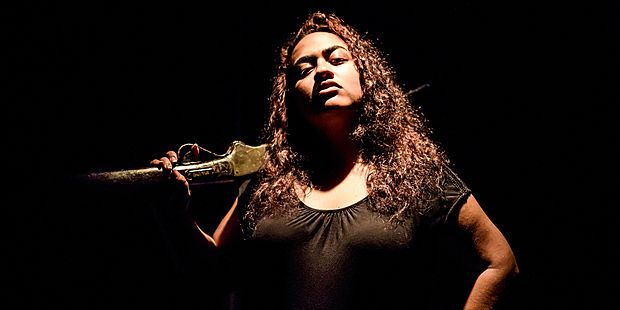Ngā Hua o te Whakamāori: New Zealand Plays in Te Reo
Ruia Taitea Creative on translating plays into Te Reo
Last year Ruia Taitea Creative, the collective behind New Lynn's Te Pou Theatre, staged their Te Reo version of Briar Grace-Smith's Purapurawhetu. This week they're about to open a second New Zealand play which has been translated into Te Reo – Gary Henderson's psychological thriller, Mo and Jess Kill Susie, directed by Tainui Tukiwaho and translated by Ani-Piki Tuari, Hania Douglas, Te Aorere Pewhairangi, and Tawaroa Kawana.
Kate Prior asked producer Amber Curreen and translator and performer Ani-Piki Tuari about translating New Zealand plays from English into Te Reo.
Ruia Taitea Creative has staged translated versions of Briar Grace-Smith’s Purapurawhetu and now Mo and Jess Kill Susie - what is the wider kaupapa behind staging translated Te Reo versions of New Zealand plays?
Amber Curreen: Ruia Taitea Creative is usually all about running the whare Te Pou Theatre in New Lynn, but we are also theatre makers and the few works we’ve chosen to present are ones we see filling a gap in the theatre scene.
Ani-Piki Tuari: Yeah, both Purapurawhetū and Mo & Jess Kill Susie are contemporary theatre shows set now which is something you don't often see in professional te reo Māori theatre; Te Reo shows are often for kids or set in the past.
AC: ...like that’s where te reo Māori “belongs”
AT: Yeah, or in translations of Shakespeare.
AC: Which are all great kauapapa, but we see a gap: staging shows that tell the story that te reo Māori belongs in the here and now.
We see a gap: staging shows that tell the story that te reo Māori belongs in the here and now.
Why were you particularly interested in Mo and Jess Kill Susie as a play to be translated?
AC: This is one of our favourite New Zealand plays, and we wanted to translate it for the wahine in the story and the complex characters. We have these three powerful actors: Ani-Piki and Krystal Lee (whose debut show was Purapurawhetū) and Ascia Maybury, who was keen on the challenge of doing a te reo Māori play. And this piece really offered them a chance to sink their teeth in.
AT: It was a great challenge to translate and a challenge to do these characters justice. They're Māori characters who could seem like standard 'bad' characters, who are so much more than that and we get to own their stories through their own language.
There are several translators on this project – can you step me through the process of how you approach the translation? How long does the process take? Is the playwright involved in the process?
AT: I think with this play it was really important for us to analyse in all three characters in depth; what they could be like, what their intentions are, and why they have chosen to be in the situation they're in. I was lucky enough to have one-on-one time with the playwright, Gary Henderson, to be able to discuss the characters and their intentions or purpose.
That said, we split the characters amongst the four of us to ensure that each character's language was consistent. Two of us focused primarily on Mo’s dialogue, purely because she has the most dialogue and it's more descriptive then the other two characters. Additionally, there are quite a few words in English that do not exist in the Māori vocabulary, so we also had to think of ways to translate the ideas behind the words rather than the exact words without it hindering the original script or changing the intentions.
We only had a month to translate the play, so even though we finished translating the show in its entirety, I am still having to translate bits and pieces here and there while we as the actors begin to physicalize and action what the characters are doing. It's an ongoing process.
The title, Mo and Jess Kill Susie has been translated to E Kore A Muri E Hokia, which roughly translates to "there's no going back" or "what's done is done". What was the thinking behind this title? What are your thoughts on literal translation compared to contextual translation?
Amber: The contextual translation is really important to us in this kaupapa and that's exemplified in the title. It honours both languages too. Generally speaking, simply translating words exactly doesn’t do justice to the English and doesn’t hold as much mātauranga Māori. The translation hasn’t just been done for translations sake – with Gary's support, we’ve adapted some parts of the piece to work with the context of these actors speaking Te Reo.
There are many theories about approaches to literary translation. Do you think translating a piece of literature differs from translating a play, where words are intended to be heard and not read?
AC: I think the realities of colloquial language are more important in translating the play.
AT: And with a play the actors are required to delve beyond what is written – they're required to action the subtext of what's being said. This meant that while translating the play we had to ensure that we were translating what was written, not just the subtext of what was written. Otherwise it might as well be a book, and it would interfere with the actors' and director's ability to make decisions on how each character is portrayed, how each scene is brought to life and how the audience may understand or interpret what is going on.
We had to ensure that we were translating what was written, not just the subtext of what was written.
We all know the phrase ‘lost in translation’ but where do you think meaning has grown through translation in this project? For example, is there opportunity in the disconnect between cultural contexts/language?
AC: The translation has changed some of the logics of the play, for example a plot point around discovering a Pākehā policewoman speaks te reo Māori. It adds another layer to the story, to the power relationship between the women.
AT: Through the reo Māori you can get a better understanding of the characters; why they're doing the things they're doing is clearer to understand. It's through the nuances, the colours, and intonations of the reo Māori I believe that allows the audience to be more empathetic to all the characters.
Mo and Jess Kill Susie is written by a Pākehā playwright and Purapurawhetu is written by a Māori playwright. Do you think this is evident in the ‘gaze’ of the work? Does this affect the translation?
AC: There will always be a difference in the ‘gaze’ of a work when a writer is writing about the unfamiliar and there's all the historical problems associated with a Pākehā playwright writing Māori stories. The translation extends the gaze of the work I think. In the translation and in Tainui's direction of the work, he's actually lifting this even further out of a specific political context, and instead placing the focus on these humans. Ahakoa he Pākeha, he Māori ranei.
I know various non-Maori speakers who attended Purapurawhetu and really enjoyed it – who would you say is your intended audience for your Te Reo works?
AT: All and everyone. The intention for myself as a translator was to bring to life Gary’s work again in te reo Māori so that it's is not seen as something that only fits into just one worldview or context, and that it's accessible and not intimidating to anyone and everyone.
Mo and Jess Kill Susie runs from Wednesday 26 April to Saturday 29 April at Te Pou Theatre, New Lynn.
Tickets available here


